
Hiking shoes provide most of what we love about hiking boots in a lightweight and comfortable package. Photo: Pippa Baker-Rabe//The Inertia
As hiking and backpacking have evolved, there has been a shift toward lighter-weight gear. And we’re here for it: We love hiking shoes for all types of hikes, as they are typically lighter, more breathable, and easier to break in than hiking boots. That’s not to say boots don’t have a place in our gear closet, but for the majority of our trail time, you’ll catch us in hiking shoes. That said, the trail shoe category is broad, making it difficult to decide what the best hiking shoes are for your needs. We’re here to help you make the call with top picks for technical ascents, all-day comfort, lightweight speed, and more.
Navigate To: Comparison Table | Buyer’s Guide | How We Tested
Related: Best Women’s Hiking Shoes | Best Hiking Boots | Other Hiking Gear Guides
Editor’s Note: We updated this guide in May 2025 with updated formatting, additional navigation, and refreshed links. We also removed out-of-stock or old-model hiking shoes.
The Best Hiking Shoes of 2025
Best Overall Hiking Shoes: Danner Trail 2650
Best Value Hiking Shoes: Merrell Moab 3
Runner-Up Best Hiking Shoes: Salomon X Ultra 4 GTX
Best Trail Running Shoes for Hiking: Hoka Speedgoat 6
Most Comfortable Hiking Shoes: Hoka Anacapa Breeze Low
Best Overall Hiking Shoes
Danner Trail 2650 ($170)
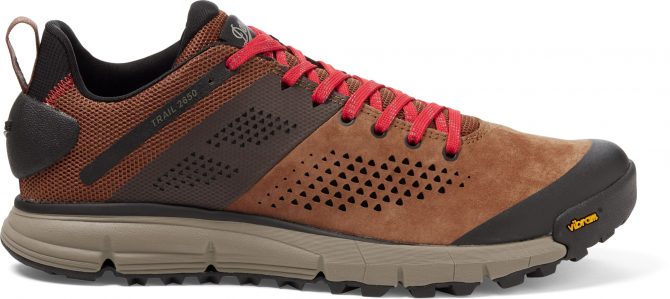
Available In: Men’s, Women’s
Weight: 12 oz per shoe
Heel-Toe Drop: 8 mm
Versions: Campo, GTX, Trail Mesh, Mid
Pros: Incredible all-around performance paired with solid looks
Cons: On the narrower side
Fit: Very snug but loosens up with time, available in wide versions as well
It’s hard for a brand to do something new with a hiking shoe, yet Danner has done it with the Trail 2650. Sure, Danner is well known as a premium boot manufacturer (and somewhat of a style guru for outdoorsy rugged types), but a hiking shoe?
2650 stands for the number of miles on the Pacific Crest Trail, which means that Danner built it for the real “hikers” out there. And we think they succeeded. We named it our best overall hiking shoe because it really does excel in all categories. It’s light enough to feel quick on the feet, yet rugged enough — with a TPU rock plate and thick leather exterior — to handle rough trails. The fit is very snug, though that loosens up with use.
The Danner Trail 2650 is comfortable immediately and offers a mix of plush midsole comfort and solid outsole support. Our team noted that these are a bit on the narrow side. The Danner Trail 2650 is also a very supportive shoe: we would have no qualms backpacking with them, and they cradle the feet quite well. Traction felt excellent in the Trail 2650, especially on dirt and gravel. It doesn’t have the lug depth as some others on this list, so it may start to struggle in scree.
The Trail 2650 is quite durable, especially the leather uppers. We haven’t reported any of the parts failing or even getting scuffed with use. However, the leather is the kind that absorbs a lot of dirt, so they do look perpetually dusty. During testing, they would wade shallow creeks in these if necessary, though we recommend being careful to make sure the water didn’t get up too far, as they sit pretty low on the feet.
We were most surprised by the midsole, which is minimal (for Danner) with an 8 mm heel-to-toe drop and a very cushioned experience. It felt good right away and has not let up. They’re also fairly stylish for hiking shoes, so most people won’t mind wearing them around town. We even threw them on for a day of yard work, and they did great.
An all-around hiking shoe for the books? We think so.
Read our full review here.
Check Price on REI Check Price on Backcountry
Best Value Hiking Shoes
Merrell Moab 3 ($140)
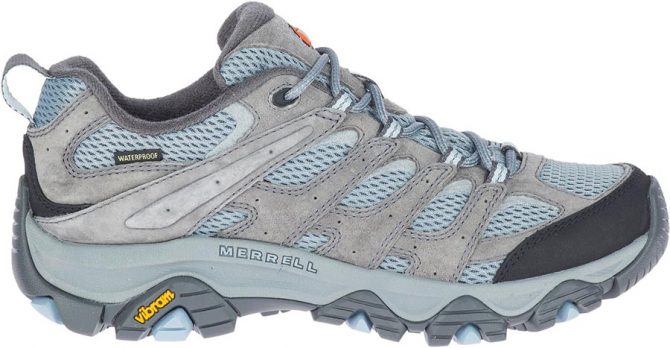
Available In: Men’s, Women’s
Weight: 17 oz per shoe
Heel-Toe Drop: 11.5 mm
Versions: Waterproof, GORE-TEX, Ventilator, Mid
Pros: Classic and well-priced hikers that fit great and have hung around for a reason
Cons: Lacks modern features, heavy
Fit: The Merrell Moab really does fit most people, but they do run a little wide in general as opposed to narrow
In the world of hiking shoes, there is perhaps no shoe more “classic” than the Merrell Moab 3. This is the “dad shoe” of hiking — the one that helped to define a category. Because of this, they are definitely of the old-school variety, with a large heel-to-toe drop, a burly appearance, and all the classic hiking shoe features, like leather uppers, thick laces, extra-large toe rand, and a clompy outsole.
That said, they’re a classic for a reason. One tester wore a pair of Merrell Moabs as his singular shoe for a 6-week travel backpacking in Southeast Asia, through jungles, smoky cities, and a heap-full of trails, and he had no issues. A decade-plus later, they are still sold, almost unchanged, and fit most people.
When compared with more plush models, the Moab is just not as comfortable. That said, they are heavy-duty enough for serious backpacking. The old-school design was all about stability. Moabs are good for backpacking, good for solid-footed hiking, and they will keep your ankle in place. A classic Vibram outsole gives the Moabs decent traction. It’s not the best on this list, but we wouldn’t worry about slipping or skidding out on most trails.
As the years go on, the durability of these classic models can decrease. We’ve seen it happen across the board, and while the Moabs are not a long-lost relic of lasting quality, they don’t have quite the staying power of older generations. We know this more from industry experience than personal testing of this pair, but we have read that they may not last past a few seasons. We did not test the “waterproof” version, and yet they are rugged enough to provide some resistance. That said, the waterproof version is recommended if you frequently hike in wet environments.
If you want a classic hiking shoe — especially one that is well-priced — and are looking for rugged materials above immediate comfort, this is a good pick. It has less finesse than other models but gets the job done.
Check Price on REI Check Price on Backcountry
Runner-Up Best Hiking Shoes
Salomon X Ultra 4 GTX ($160)
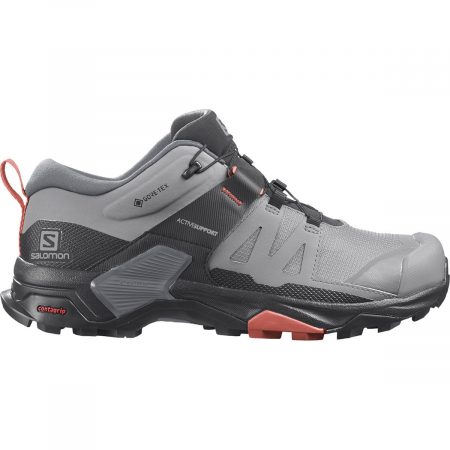
Available In: Men’s, Women’s
Weight: 12.8 oz per shoe
Heel-Toe Drop: 11 mm
Versions: Mid
Pros: High-tech features provide top-tier hiking shoe performance
Cons: Narrow fit, not the most stylish
Fit: Fit is subjective, but Salomon runs very narrow – we had to test the “wide” version, and they are still a tad snug, otherwise, the sizing runs true
Editor’s Note: The Salomon X Ultra 4 is going out of stock to make way for the new 5. We’ll get our feet in those and update with our findings.
The Salomon X Ultra 4 GTX hiking shoes are beasts. There’s just no other way to put it. The shoe is relatively lightweight, looks and feels burly when worn, has many features unique to Salomon, and is built to last a long time. It’s often ranked as a top hiking shoe for a reason, and when we took it on the trails, it proved excellent in all categories, specifically grip and durability.
Of particular note, the QuickLace system works very well. Instead of tying laces like some traditional shoe-wearing person, you can just pull on the QuickLaces, lock the drawstring, tuck them in the included tongue bed, and know your shoes will fit snugly for your entire hike.
This is a more traditional, heavy-duty hiking shoe, so you get a much less springy feel than a trail runner, but the comfort remains solid. It’s built to help you carry large loads and has a firm step. The X Ultra 4 GTX also has an orthopedic insert and thick foam tongue, which adds to the overall feel. For a hiking shoe at this weight, the support is unmatched. Each step is surefooted, the shoe is slim and hugs well to the foot, and the stiffer sole is built for backpacking. Outside of a boot, we can’t imagine a sturdier hiking shoe.
The Contragrip outsole has a reputation that precedes it, and we were blown away by the traction, especially in muddy wet ground and river rock hopping. It’ll be hard to slip in these. Even after mud, water, and rocky traverses, the X Ultra 4 GTX is holding up very well. The exterior is a synthetic material that’s very tough to the touch, and the outsole has zero signs of degradation or snagging after hiking on rocks. Each feature of the X Ultra 4 GTX feels like it was made to last.
Salomon knows how to build a shoe with a waterproof lining. The X Ultra 4 GTX has “GTX” in the name because they use Gore-Tex waterproofing, which is still industry-standard for both water protection and breathability. The X Ultra 4 GTX did feel much warmer to wear than the Speedgoat 5, for instance, but they still managed to breathe on hot days. Even after river crossings, our socks stayed dry.
Check Price on REI Check Price on Backcountry
Best Trail Running Shoes for Hiking
Hoka Speedgoat 6 ($155)
Available In: Men’s, Women’s
Weight: 9.8 oz per shoe
Heel-toe Drop: 5 mm
Versions: Low, GTX Low, GTX Mid
Pros: Great stability and traction for such a light shoe, improvements in durability
Cons: Pretty narrow fit isn’t suitable for everyone
Fit: A touch long and narrow; the flexible upper accommodates most feet, but it is a slender, snug fit
The Hoka Speedgoat 6 continues a legacy of awesome trail running shoes, and this latest iteration is one of our favorites. It’s firm, snug, and ready to rip mile after mile. The Speedgoat 5, while comfortable, was a little plodding and prone to wearing out prematurely. Not so with the revamped 6: We’ve already got about 150 miles on them and they barely look broken in. The firmed-up midsole, tougher upper, and improved Vibram outsole all seem to be working wonders for the durability of this hiker.
It’s important to note that the Hoka Speedgoat 6, like the line before it, is a narrow, tight-fitting shoe. It’s going to feel restrictive if you’re all about the wide, Altra-style shoes, but that snug fit provides excellent stability for a very lightweight hiking shoe (just about 10 ounces per shoe). It can accommodate wider feet, but just be aware that it’ll fit close to your foot, and thin socks are optimal here.
We love how stable and planted this trail runner feels—where many hikers might be scared off by a lighter-weight option, the Hoka Speedgoat 6 provides plenty of traction and stability. If you need a bit more support, check out the Mid GTX version, which has an adjustable ankle collar.
Check Price on REI Check Price on Backcountry
Best Max-Cushion Hiking Shoes
Hoka Anacapa Breeze Low ($155)
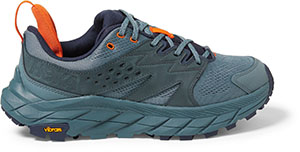
Available In: Men’s, Women’s
Weight: 12.4 oz per shoe
Heel-toe Drop: 6 mm
Versions: Low, Mid
Pros: Stable and supportive soles with great traction
Cons: Upper is not as durable as the non-breeze version
Fit: The fit is superb, with a recycled PET material that adapts to the foot with ease
Hoka is known as a running shoe company, but that certainly hasn’t stopped them from creating a heavy-duty hiking shoe. The Hoka Anacapa Breeze Low is one of our favorite hiking shoes from a running company.
The uniqueness of Hoka has always been the oversized midsole with obscene amounts of cushion, and they mostly kept this intact for the Anacapa Breeze. However, where the traditional Hoka midsole, which can be found in the Speedgoat, is very springy, the Anacapa has a firmer, more planted feel. The Breeze version is designed to be a tad lighter and more breathable, making this shoe ideal for hotter climates.
The upper is quite different from a classic Hoka. You’ll notice simple, solid color options from a brand that usually leans toward bright, flashy shoes. But it’s more than that — the company uses recycled PET in the upper, which makes it feel not only lightweight but provides a nice snug fit.
If peak comfort is the squishiest, cloud-like walk you can imagine, the Anacapa Breeze Low comes in just under that. They aren’t an immediate knockout, especially for day hikes, because they have a heavy-duty feel and step to them. However, once you add a bit of weight and wear them in, the Hoka comfort starts to shine. As far as stability is concerned, for a low-cut shoe from a running company, we were quite impressed. Hoka managed to get a sturdiness in the Anacapa we weren’t expecting, and we would have no issue backpacking in these shoes. The combination of the ultra-thick midsole and supportive, semi-stiff upper provides a good combo.
Vibram Megragrip is industry excellence for a reason, and the lug pattern on the Anacapa does not disappoint. It’s still not the best on the market for scrambling, but for most users on lighter trails, these will do wonders. All-around build quality is top-notch.
Check Price on REI Check Price on Backcountry
Best of the Rest
Burly and Supportive
La Sportiva Spire GTX ($209)
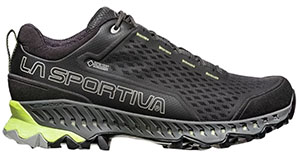
Available In: Men’s, Women’s
Weight: 15.5 oz per shoe
Heel-toe Drop: 10mm
Versions: Low
Pros: Waterproof yet lightweight
Cons: Pricey
Fit: Fit is snug but quickly breaks in (be mindful of EU sizing)
What makes a good hiking shoe? Although that answer is subjective, we have a few must-haves: Good traction, comfort, and durability. La Sportiva checks all these boxes and includes a Gore-Tex Surround membrane on their Spire GTX. The shoes offer an Ortholite footbed for a superb feel right out of the box. Where the shoes really shine, though, is in the outsole. Made using Vibram’s XS Trek outsole, we felt that we could conquer any terrain that we traversed with ease and stability. That is thanks to a lug pattern that angles in to help you stay upright, even when the ground underneath is off-camber or rocky. The grip speaks for itself and people often seek out Vibram soles for this reason.
Being a waterproof shoe, it weighs a bit more than others, but we’re really only talking about ounces here. It’s still under a pound each, and the exceptional sole and stability well make up for any qualms with weight. Anyone who has used Gore-Tex knows that it’s the real deal, and to have these on shoes makes all the difference, especially in coastal climates where we tested and socks stayed dry throughout the process.
There isn’t much bad we can say about these shoes, only that the price is a bit higher than others. However, we feel that the outsole and waterproofing make up for the higher price tag. It only takes one wet sock to ruin your day. Add in the great support underfoot and you have a winning pair of hiking shoes with the Spire GTX.
Check Price on Backcountry Check Price on Amazon
Great Stability and Value
Oboz Sawtooth Low ($160)
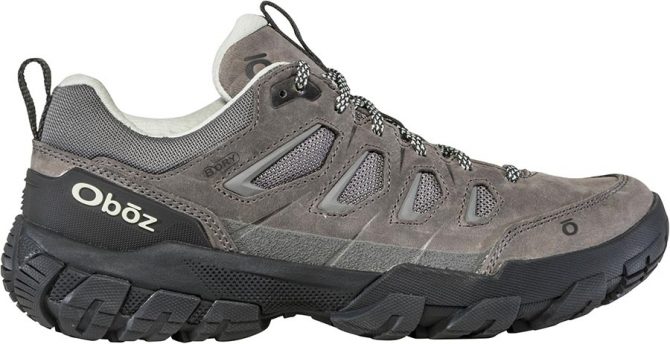
Available In: Men’s, Women’s
Weight: 15.6 oz per shoe
Heel-toe Drop: Not Listed
Versions: Waterproof, Mid
Pros: Incredibly durable
Cons: Heavy
Fit: Shoe is snug but breaks in with time
Oboz hails from Montana and is one of the new classic outdoor shoe companies. They make heavy-duty boots for serious outdoor trekking, and the Sawtooth Low is their beastly design trimmed down (a bit) into a hiker. The outsole is a serious design feat, and the durability is unmatched. But get ready to feel the weight with every step.
At nearly a pound per shoe, the Sawtooth trends more toward hiking boots than shoes. However, many hikers don’t like the somewhat restrictive feel of a mid-top, yet seek the support and stiffness of a proper hiking sole; the Oboz Sawtooth Low is the shoe for you. Well-made and well-designed, we recommend these shoes for lengthy backpacking trips and other hard-wearing pursuits. Like many heavy-duty hiking shoes, the Sawtooth requires a break-in period, but once formed to your foot, you’ll have a trusty, supportive shoe designed for the long haul.
Check Price on REI Check Price on Backcountry
Pared Down but Supportive
Merrell Moab Speed 2 ($140)
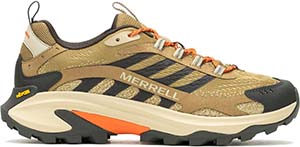
Available In: Men’s, Women’s
Weight: 12 oz per shoe
Heel-toe Drop: 10mm
Versions: Low, Mid, Mid GTX
Pros: Great breathability, no break-in period
Cons: Not a tight fit for narrower feet
Fit: Pretty spacious, especially for narrow feet
While the Moab Speed 2 shares part of its name with its thicker sibling listed above, the shoe has a much different feel than the Moab. It’s built for speed and efficiency on the trail and lived up to the challenge. The Vibram outsole is as good as anything for traction and stability on or off trail, while the cushioned midsole provides a great middle-ground between a minimalist shoe and some of the heavier shoes we tested.
We tested the non-waterproof version, which proved to be lightweight and nimble. The shoe features a bit more pronounced rocker shape than the standard Moab, which we felt propelled us down the trails more readily. Plus, we dig the retro stylings of this shoe. If you like the sturdiness and looks of a classic hiking shoe but want a more agile option, the Moab Speed 2 is a worthy choice.
Read our full review here.
Check Price on REI Check Price on Backcountry
Oboz Katabatic LT Low ($145)
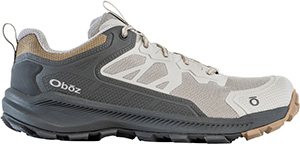
Available In: Men’s, Women’s
Weight: 12.7 oz per shoe
Heel-toe Drop: 8mm
Versions: Waterproof, Wind, Mid, Mid Waterproof
Pros: Great cushioning
Cons: Laces can get undone when dusty
Fit: Good for most foot types: spacious without feeling big
Cushioning is the first thing that stands out with the Oboz Katabatic LT Low. As soon as we put them on, the softness was a welcome treat. But that’s not to say that it’s excessive. Rather, it’s a sweet spot between comfort and stability, while still being able to feel the ground underneath. The Katabatic Low is a bit less rugged than the Sawtooth listed above but still can go pretty much anywhere save for big alpine treks. Even as walking shoes around town they feel great and look good too.
The Katabatic is responsive enough to make you feel as though they are helping you to go faster. That kind of bounce is tough to achieve in a hiking shoe, so we appreciated the midsole technology Oboz has packed into the Katabatic. After long days, they still felt great, even the waterproof version, which breathes surprisingly well.
There isn’t much negative to say about these shoes — we really enjoyed the amount of balanced cushioning, breathability, and good looks. The big drawback was the laces: for some reason they wouldn’t stay tied, especially in dusty conditions.
Check Price on REI Check Price on Backcountry
Altra Olympus 5 Hike Low GTX ($200)
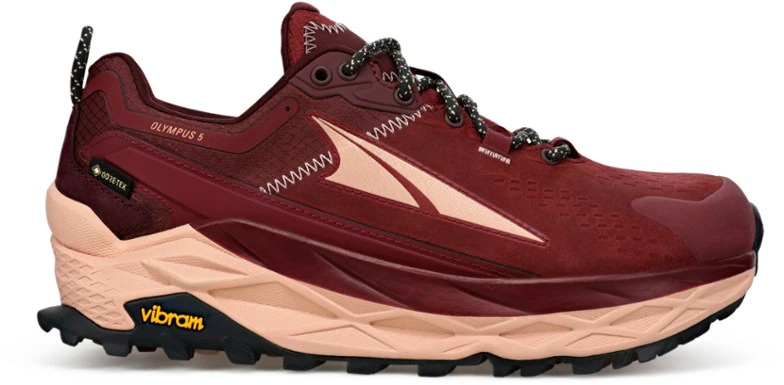
Available In: Men’s, Women’s
Weight: 13.25 oz per shoe
Heel-toe Drop: 0 mm
Versions: Low GTX, Mid GTX, and Olympus 5
Pros: Zero-drop shoes with plenty of comfort and support
Cons: Wide toe-box
Fit: A wider fit with extra room in the toe box
Designed with comfort and performance in mind, the Altra Olympus 5 Hike Low GTX features Altra’s trademark “Balanced Cushioning,” which helps position your heel and forefoot at an equal distance from the ground, which works to promote better alignment and form while hiking. Like all of Altra’s shoes, the Low GTX has a zero-drop design and a wide toe box that allows your toes to spread out naturally.
In terms of comfort, there are some pros and cons to the Hike Low GTX. If you’ve never worn a zero-drop shoe before, your calves are going to be sore. It’s best to start off by wearing your Altras on short walks and build up to longer hikes to give your calves some time to adjust. As an avid runner and hiker, our women’s tester didn’t have any issues and found these shoes to be really comfortable. However, those with narrow feet might find the wide toe box takes some getting used to.
These shoes have a lot of cushioning underfoot, providing plenty of support on rough and rocky terrain. If you’re used to more barefoot or minimalistic style shoes it may be too much for you, but we enjoyed having the extra cushion.
Just like a pair of running shoes, these hikers delivered plenty of reliable traction thanks to the Vibram Megagrip and canted lugs on the outsoles. In terms of waterproofing, the Low Hike GTX sports GORE-TEX waterproofing technology that ensures your feet stay dry, just so long as you don’t submerge past the ankle.
Read our full review here.
Check Price on AmazonLems Primal Pursuit ($130)
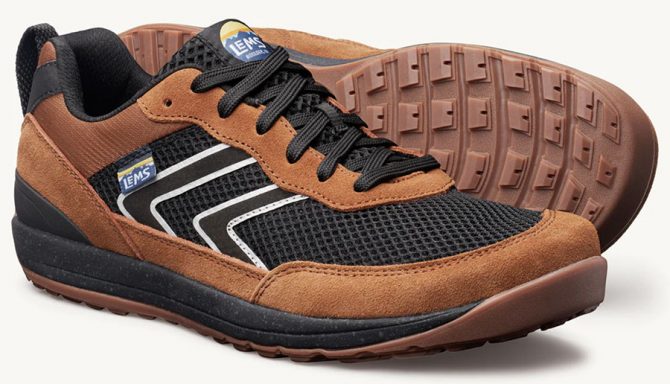
Available In: Men’s, Women’s
Weight: 10.3 oz per shoe
Heel-toe Drop: 4 mm
Versions: Low, GTX Low, GTX Mid, GTX Spike
Pros: Lightweight with barefoot feel and great styling
Cons: Don’t have the ruggedness required for longer, tougher hikes
Fit: These shoes are on the wider side, especially in the toe box. Lems has a great track record of saying exactly how their shoes fit, down to the colors, so trust the website when you’re looking for sizing.
Editor’s Note: Stock is getting pretty low for the Lems Primal Pursuit. We still love this as a wide option, but we will update this if they go fully out of stock.
The Lems Primal Pursuit is an interesting blend of stylish design and minimalism built into an all-around hiking shoe. They fit squarely in the “crossover” category, and while they did fine on easy day hikes, the shoes are not built for anything too rough and tumble. They are extremely lightweight (10.3 ounces), and due to the zero drop stack height, they actually do a very good job of living up to the “barefoot” concept they were designed after (and which the entire Lems brand was designed around).
The Lems Primal Pursuit is the middle of the road for comfort. One could argue that comfort is relative here, but when put against some of the other very large, squishy midsoles of other shoes in this guide, they just don’t provide as much luxury cushion. Likewise, the Primal Pursuits are much more built for a lightweight hike than a backpacking trek. They weigh very little and offer medium support for trekking.
We found the traction to be quite good for the depth of the lugs and the lack of a beefed-up outsole. They held grip on the same muddy trails as other shoes, but we’d be hesitant to take them on extended wet hikes with rocks or shale. The breathability on the Primal Pursuit is outstanding, which typically means the durability is somewhat questionable. The thin mesh that comprises most of the upper feels like it could scuff easily, but the vegan-leather parts of the upper are well-built. This is not a waterproof-lined shoe, which we didn’t mind for its best use case.
Finally, they are indeed brewery-worthy. You could take them to a co-working space, a mid-day hike with the dog, and a dinner at the end of the day. Granted, our feet and calves were a little tired, but for those who love zero-drop shoes, these are a real winner.
Vasque Re:Connect Here ($130)
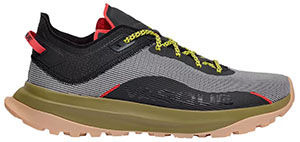
Available In: Men’s
Weight: 10 oz per shoe
Heel-toe Drop: 6mm
Versions: Low
Pros: Recycled and bio-based materials, lightweight
Cons: Upper material is a bit flimsy
Fit: Versatile fit due to flexible upper
Note: With Vasque announcing its closure, the Re: Connect will soon be discontinued. We still recommend it, and it’s available at a great deal, but we’ll remove it when it’s no longer in stock.
A lot of companies claim to be moving toward sustainability, which is great, but many are slow to action when it comes down to it. But for Vasque, an American company devoted to building great hiking boots and shoes, they are walking the walk — or hiking the hike. Their Re:Connect line uses recycled polyester upper material and an algae-based Bloom footbed and partial sugarcane EVA midsole to deliver a hiking shoe that takes less out of the environment to help us get out there more.
As one of the lightest shoes on the list, we appreciated how easy it is to move around in these. The mesh upper contributes to that, although definitely lacks support. However, the shoes come with a heel collar to help keep the foot snug, so the fit still feels great. You won’t pick these for super muddy trails or sharp, rocky terrain. But for a light hiker that is great on the streets as well as most trails, the lightweight feel and responsive cushioning are worth your attention.
Xero Scrambler Trail Low WP ($149)
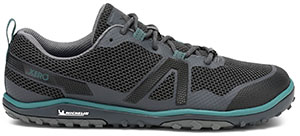
Available In: Men’s, Women’s
Weight: 11.6 oz per shoe
Heel-toe Drop: 0mm
Versions: Low, Mid
Pros: Super light with a grippy sole
Cons: No ankle support
Fit: Spacious and easy to dial-in fit
While this is more of a trail runner than a hiker, we still felt that this shoe was awesome at any speed. The more updated waterproof version, the Xero Scrambler Trail Low WP, weighs in at less than 12 ounces yet has a remarkably tacky Michelin outsole to keep you upright no matter the terrain. We tested this on both coastal granite and interior dusty trails of the high desert, and the shoe handled it all. Because it’s a pared-down shoe, the ankle support isn’t what you’d get in other models, but as long as you’re not lugging a heavy pack, you should be all good.
The zero-drop style and thinner outsole create a connected, responsive feel. It’s no surprise that more people join the barefoot shoe movement each season. While it’s not a do-all type of shoe, the situations that it does call for will help your body have a relationship with the ground like never before. It’s definitely something worth trying for yourself to see whether you benefit from them, and Xero is a good place to start. They guarantee their soles for 5000 miles, which will be more than enough time to decide if it’s right for you.
If minimalism is your idea of a good hike, then perhaps these are the shoes you’ve been looking for.
Check Price on REI Check Price on Xero
Best Hiking Shoes Comparison Table
| Shoe | Price | Weight (per shoe) | Heel-Toe Drop | Versions |
| Danner Trail 2650 | $170 | 12 oz | 8 mm | Campo, GTX, Trail Mesh, Mid |
| Merrell Moab 3 | $140 | 17 oz | 11.5 mm | Waterproof, GORE-TEX, Ventilator, Mid |
| Salomon X Ultra 4 GTX | $160 | 12.8 oz | 11 mm | MidLow, GTX Low, GTX Mid, GTX Spike |
| Altra Lone Peak 8 | $150 | 10.7 oz | 0 mm | All-WTHR Low, All-WTHR Mid, Hiker, Alpine |
| Hoka Speedgoat 6 | $155 | 9.8 oz | 5 mm | Low, GTX Low, GTX Mid |
| Hoka Anacapa Breeze Low GTX | $155 | 12.4 oz | 6 mm | Breeze, Mid |
| La Sportiva Spire GTX | $209 | 15.5 oz | 10 mm | Low |
| Oboz Sawtooth Low | $160 | 15.6 oz | N/A | Waterproof, Mid |
| Merrell Moab Speed 2 | $140 | 12 oz | 10mm | Low, GTX, Mid, Mid GTX |
| Oboz Katabatic Low | $145 | 12.7 oz | 8 mm | Low, Low waterproof, Mid, Mid waterproof, Wind |
| Altra Olympus 5 Hike Low GTX | $200 | 13.25 oz | 0 mm | Low GTX, Mid GTX, and Olympus 5 |
| Lems Primal Pursuit | $130 | 10.3 oz | 4 mm | Low, GTX Low, GTX Mid, GTX Spike |
| Vasque Re:connect Here | $130 | 10 oz | 6mm | Low |
| Xero Scrambler Trail Low WP | $149 | 11.6 oz | 0 mm | Low, Mid |

We tested a wide range of hiking shoes to pick the best. Photo: Pippa Baker-Rabe//The Inertia
How We Tested Hiking Shoes
We called in the whole testing team for this guide. Hiking testers included Nathan Lemin, Rebecca Parsons, Rebecca Sperry, Daniel Zweier, and Steve Andrews. Together, we bring decades of experience in hiking shoes, with robust backgrounds in backpacking and trail running.
For this guide, we combined real-time testing on the glorious trails of backcountry southern California, the rugged verticality of the Hawaiian island of Oahu, the harsh and beautiful White Mountains of New England, and the steep granite terrain of British Columbia’s Coast Mountains. Our team has a long-standing knowledge of hiking shoe models and their development, and we have researched the numerous reviews that readily exist (and which you’ve surely perused) on all these models. We got our hands on — rather, our feet in — all the shoes listed here in the review, as well as many that didn’t make the cut, and have spent our fair share of miles in every shoe featured here.
This article was first published in the spring of 2023. After publishing our Best Hiking Shoes for Women later in the season, we updated this article with some top picks for women’s hiking shoes. In October 2023, we added information to the buyer’s guide to help folks choose the best hiking shoes for them.
After another year of testing hiking shoes, we updated this article again in May and November 2024, replacing some of our top picks that were either no longer readily available or no longer represented the best of the best. We removed some shoes from the list and again added more information to the buyer’s guide.

Lacing up our favorite trail running shoes for hiking: the Hoka Speedgoat 6. Photo: Nathan Lemin//The Inertia
Hiking Shoes Buyer’s Guide
What Is a Hiking Shoe?
People throw the term hiking shoe around all the time, and they don’t always mean the same thing. For the purposes of this guide, hiking shoes are low-top shoes built for hiking on trails. The hike you’re on could be a simple day hike, a gnarly 15+ mile full day, or a backpacking trip, but the trail is key. For this guide, we’re talking about hiking shoes that are “low cut,” or sit below your ankle. Specifically, not hiking boots, which we covered in Best Hiking Boots and Best Hiking Boots for Women. This subset of gear can occasionally include trail running shoes, urban hiking shoes, and other varieties, so long as you wear them on a trail and they provide adequate comfort and traction when using them to hike.

Consider your tread and outsole rubber when selecting hiking shoes—Vibram makes some of our favorites. Photo: Rebecca Sperry//The Inertia
What Hiking Shoes Should I Get?
This is the question most people start with, and the one you inevitably ask the hip, outdoorsy staff at REI when you head to the great wall of shoes. The answer is as facetious as it is simple: get the hiking shoes you will actually wear for the activity you actually do. Too often, we see burly, heavy, overly rugged shoes lusted after by people who mostly go on walks on that paved trail by the river through the center of town. Yes, it’s fun to wear a fancy, technical, capable pair of hiking shoes. But it’s not always the right choice, and often the most rugged doesn’t equate to the most comfortable. We tend to split hiking shoes into three main categories: Light Hiking Shoes, Heavy-Duty Hiking Shoes, and Crossover Hiking Shoes.
Light Hiking Shoes
Light hiking shoes typically refer to the materials used in the upper, the weight of the shoe, and how aggressive the outsole is. These could be trail running shoes like the Hoka Speedgoat 6 or Altra Lone Peak 8. They are excellent for day hikes, breathability, and speed, and will keep a spring in your step. However, they’re not always ideal for really rough terrain or long distances with a heavy backpack.
Heavy-Duty Hiking Shoes
Heavy-duty hiking shoes are beefed-up shoes and typically what’s recommended to folks who want a “hiking shoe.” They often have leather uppers for enhanced durability, aggressive outsoles with thick lugs and large toe rands, come in waterproof models, may have rock plates to protect your feet against rocky trails, and are built to last many years. Very capable of any kind of hiking and backpacking, though if you prefer ankle support with a heavy pack, a hiking boot may be better.
Crossover Hiking Shoes
Crossover hiking shoes are more casual in nature, both in how they look and their technical capability. They are billed as the shoes that go “from trail to town” and can serve as your everyday shoes if you like wearing hiking shoes all the time. Our top pick in this category (and overall) was the Danner Trail 2650; we recommend the Danner because it performs on the trail as well as it looks in town.
In order to pick a hiking shoe, we always recommend identifying the type of activity you would do with said shoes from the list above. Pick the most common activity — if you go on 1-2 mile hikes every week and backpacking once every couple of years, you’re probably fine with a light hiking shoe. But if you backpack frequently or need a pair for a long trip where the miles and terrain will be tough, get a shoe that can handle the journey.

Altra has popularized zero-drop shoes—we love the Lone Peak 8. Photo: Rebecca Parsons//The Inertia
What’s the Deal with Stack Height and “Heel to Toe” Drop?
In recent years, the actual construction of hiking shoes has come into more mainstream conversation. This is partly marketing jargon, but it’s also due to trail running shoes and the running shoe industry generally making a big splash in the “outdoor” shoe realm.
Stack Height
Stack height is the literal height of the midsole of your shoe — how many millimeters the shoe brings your foot off the ground. This corresponds to how much cushion you feel and how much your feet actually feel the ground.

The Vasque Re:Connect Here is breathable with enough traction for off-trail fun. Photo: Steve Andrews//The Inertia
Heel-to-Toe Drop
Heel-to-toe drop is the slant of the shoe — how many millimeters the shoe angles your foot from your heel to your toe. This corresponds to the arch of your foot and the motion of your gait. A higher heel-to-toe drop means your gait is heavily assisted, while a zero heel-to-toe drop means your shoes mimic the design of your foot, which doesn’t slant at all.
Barefoot Hiking Shoes
The “barefoot” shoe movement has taken off since Born to Run, and many runners, hikers, and even backpackers swear by minimal, zero-drop shoes that provide basic protection, maybe some cushion, but mostly let your feet walk hundreds (if not thousands) of miles without much assistance. If you have never felt like traditional hiking boots or shoes felt very good or like they really altered your gait, consider a lower-drop shoe.
Running shoe brands, like Hoka or Altra, often make shoes with a lower heel-to-toe drop, and traditional hiking boot brands, like Merrell and Oboz, tend to have a large drop.
Waterproof Hiking Shoes
Many shoes on this list come in regular models and waterproof models. “Waterproof” is technically a misnomer — it’s not like the shoes are wrapped in plastic that can’t be penetrated by moisture. Waterproof means there is a special liner on the shoe — sometimes on the very outside, sometimes between the exterior layer and interior shoe lining — that is filled with small pores that are built to let air escape while preventing moisture from entering.
It’s a lot of tech inside your sneaker, but it does work. Waterproof hiking shoes do repel water, and the best of them will keep your socks and feet dry, but they are also typically hotter, heavier, and more expensive. It’s important to note that waterproof hiking shoes repel water to a degree. Hiking in a light drizzle is very different than hiking through a long downpour or wading through a river. No shoe is going to protect you from that. Many hikers who prefer the lightweight variety of hiking shoes also prefer those without waterproof membranes because they breathe much better.

Offering comfort out of the box, the Danner Trail 2650 is lightweight yet rugged, supportive, offers reliable traction, and is stylish to boot.
How to Assess Fit and Comfort
Fit and comfort are paramount when choosing hiking shoes, as these factors directly influence your hiking experience. Here’s what to consider:
Size and Fit: Hiking shoes should fit snugly around your mid-foot and heel, with enough room to wiggle your toes. When trying shoes on, wear the socks you plan to hike in and test them later in the day when your feet are more swollen.
Break-In Period: While many modern hiking shoes are comfortable right out of the box, some may require a break-in period. Light hiking shoes generally have a shorter break-in period compared to heavy-duty options.
Insole and Support: The quality of the insole affects arch support and comfort. If you’re not getting adequate arch support, consider replacing the included insole with an aftermarket one that better suits your foot’s arch and shape.

The Gore-Tex Surround membrane on La Sportiva’s Spire GTX really works to keep feet dry. Photo: Steve Andrews//The Inertia
Materials and Durability
The materials used in hiking shoes not only affect their weight and comfort but also their durability. Here’s what to keep in eye on:
Upper Material: Materials like leather offer durability and resistance against wear and tear, while synthetic materials are lighter and often more breathable, but might wear out sooner.
Outsole Material: Look for outsoles made from durable rubber with deep lugs for traction. Vibram soles are a popular choice known for their longevity and grip. Our testing team frequently recommends hiking shoes that feature Vibram outsoles.
Reinforcements: Additional features like toe caps and heel counters can significantly enhance durability by protecting against rocks and roots.

The Hoka Anacapa Breeze offers lightweight cushioning that feels like walking on a cloud. Photo: Steve Andrews // The Inertia
Understanding the Role of Technology in Hiking Shoes
Advancements in technology have revolutionized hiking shoe designs, enhancing their functionality and comfort:
Gore-Tex and Other Waterproof Technologies: While previously discussed, it’s worth noting how these technologies impact the internal climate of your shoes, balancing moisture management with breathability. Gore-Tex, while effective at keeping moisture out of a hiking shoe, still cannot maintain the same breathability as a non-waterproof option.
Advanced Lacing Systems: Some hiking shoes feature quick-lace systems or hooks that make it easier to achieve a consistent and secure fit.

When it’s time to replace your hiking shoes, come check out our helpful guide. Photo: Nathan Lemin//The Inertia
When to Replace Your Hiking Shoes
Understanding when to replace your hiking shoes is crucial to avoid discomfort and injury:
Mileage Indicator: Most hiking shoes are good for 300-500 miles, depending on the terrain and your hiking style. Keep track of your mileage to know when it’s time for a new pair.
Wear Patterns: Pay attention to the outsole wear. Uneven worn-out patterns can indicate it’s time for replacement, as well as a loss of traction.
Midsole Compression: If the midsole feels less responsive or you start feeling more rocks and roots through the sole, it might be time to consider new shoes.

Xero’s Scrambler Low is light and nimble, with a super grippy zero-drop sole. Photo: Steve Andrews//The Inertia
Environmental Considerations
As an environmentally conscious hiker, consider the following:
Sustainability Practices: Some brands use recycled materials and sustainable practices in manufacturing their hiking shoes. Choosing these can reduce your environmental footprint.
Vegan Options: If you prefer not to use animal products, look for vegan-certified hiking shoes that use synthetic substitutes.
Return to Top Picks | Return to Comparison Table
Editor’s Note: Don’t miss our guide to the Best Women’s Hiking Shoes. Looking for something more supportive? We’ve got you covered with our Best Hiking Boots and Best Women’s Hiking Boots. For more gear reviews and features on The Inertia, click here.



